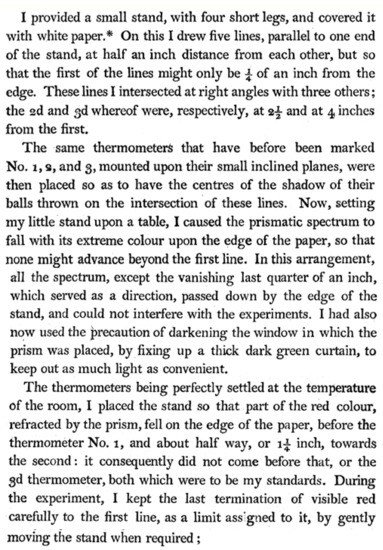Your browser does not fully support modern features. Please upgrade for a smoother experience.
Please note this is a comparison between Version 1 by Waldemar Andrzej Minkina and Version 2 by Jessie Wu.
ThDear Sisrs,
I would likentry is mainly about the story of inf to inform you that I accept the draft that you have prepared and thank you for the invitation to create it. Unfortunately, due to my heavy workload, I will not be able to do anything more for you in this matter.
Best regared radids and please understand my decision
Watldemar Minkiona
- infrared radiation
- Herschel's experiment
- thermography
- thermovision
- thermal imaging
- discovery of infrared radiation
D1. Discovery of Infrared Radiation
The discovery of the existence of infrared radiation by Herschel was related to his research on modernising the construction of his telescopes. He was looking for a filtering material with which, during solar observations, he could reduce the brightness of the Sun’s image in his telescope. While testing a number of samples of coloured glass that gave a similar reduction in brightness, he was intrigued by the fact that some of the samples transmitted little solar heat, while others transmitted so much heat that he risked damaging his eye within a few seconds of observation.
Figure 1c shows a view of F.W. Herschel’s research stand. This figure was scanned directly from his original article [1][8]. He observed the thermal effects of radiation falling into particular ranges of the solar spectrum. Along the spectrum (1), obtained by splitting solar radiation through a glass prism (2), he placed on a sliding table (3) blackened receptacles of sensitive mercury thermometers (4), which were radiation detectors. The energy of the incident radiation was absorbed by the blackened containers, and therefore, the thermometers placed in the spectrum indicated a temperature higher than the ambient temperature. The results of measurements of the temperature distribution along the spectrum of solar radiation (1) obtained from the experiment are presented in Figure 2. Herschel noticed that the thermometers placed outside the red border of the visible spectrum indicated a greater increase in temperature than the thermometers placed in particular visible ranges of the spectrum. The experiment showed that the limits of the solar spectrum do not coincide with the visible limits and that the red region is directly connected with the region of radiation invisible to the naked eye, which undergoes less refraction in the prism. He used the name “invisible rays of the Sun”, “dark heat” or “invisible thermometrical spectrum” to describe this newly discovered radiation. A little later, it was called infrared radiation because its spectrum lay outside the red limit of the visible spectrum.
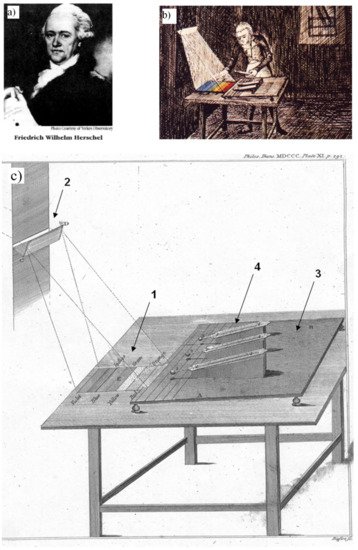
Figure 1. (a) Photograph of Dr Frederick William Herschel and (b,c) drawings illustrating his experience connected with the discovery of infrared radiation: 1. spectrum of solar radiation (colours from left, according to Herschel’s markings: violet, indigo, blue, green, yellow, orange, red), 2. prism in the window through which the solar radiation falls (a thick dark green curtain was installed in the window), 3. measuring table, 4. mercury thermometers numbered: 1,2,3 (from left to right); the drawing was made by the graphic artist James Basire [2][3][1][6,7,8]; (c) is an original drawing of the measurement stand.
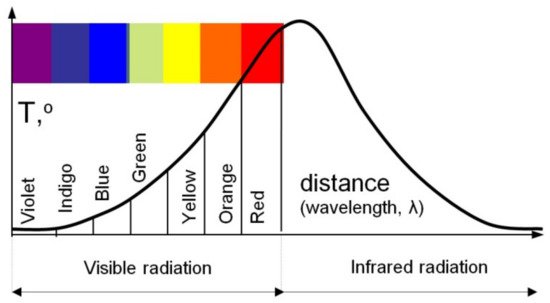
On 17 March 1800, Dr Herschel sent an article describing this phenomenon to the editors of the journal “Philosophical Transactions of the Royal Society of London” [1][8]. It should be emphasised that Herschel was a metrologist who was the first to describe his experience concerning the discovery of infrared radiation with truly metrological care. On Figure 3 are some original sentences, as Herschel described his experience, taken from his publication [1][8]:
2. Other Experiments of F. W. Herschel Related to Infrared Radiation
2.1. Investigation of the Value of Influence of Individual Colours of Split Sunlight on the Heating of Objects
Another problem that William Herschel addressed was the effect of different colours of the rays of the light spectrum on the ability to heat and illuminate objects. To this end, he carried out a number of experiments with different coloured dimming glasses mounted in telescopes [4][9]. He noticed that the use of some of them caused, apart from the different coloured image of the Sun seen through the optics of the telescope, a distinct feeling of heat, while others did not cause such an effect, transmitting only large amounts of light. This led him to theorise that the illumination and heat produced could be influenced by the colour of the Sun’s rays.
In order to dissipate his doubts concerning the nature of the observed phenomenon, William Herschel constructed the following measurement stand (Figure 4). It consisted of a cardboard plate with an oblong hole cut out of a small width, placed on a tripod, three mercury thermometers with round tips (sensitive parts) painted black, placed on slanting stands. The whole was placed on a smooth board, for easier manoeuvring of the whole stand without moving the individual elements. Next, he placed a prism in the window and directed the resulting spectrum onto the table with the research apparatus, so that only one dispersed colour of the rays would pass through the hole cut in the cardboard plate, falling then on the sensitive parts of the thermometers.
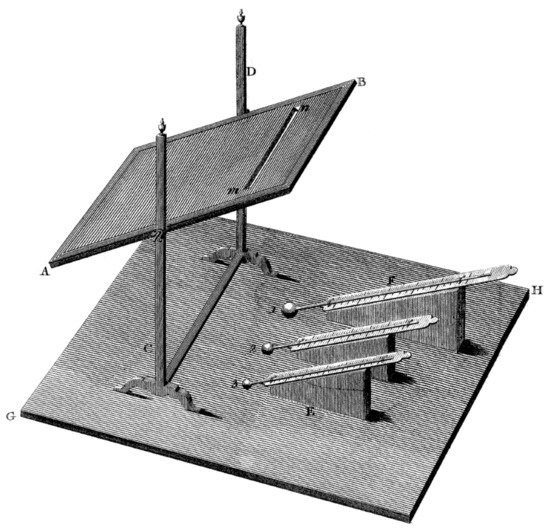
Figure 4. Measurement stand for the investigation of the value of influence of individual colours of split sunlight on the heating of objects—original drawing of the measurement stand [4][9]. Piece of pasteboard AB (plate X) in a frame, mounted upon a stand CD and moveable upon two centres; mn—an opening in the pasteboard, a little larger than the ball of thermometer; EF—three thermometers 1, 2 and 3 upon small inclined planes upon a small plain board GH.
The research confirmed the above thesis by saying that coloured rays created as a result of splitting by means of a prism differ in the heating power of the objects investigated, which were sensitive parts of mercury thermometers.
On the pages of his next, two-part article [5][6][10,11], he focused on confirming the existence of invisible heat rays, this time investigating their reflectivity, focusing, refraction and permeability.
2.2. Investigation of the Phenomenon of Reflection of Infrared Radiation
In order to carry out an experiment showing the phenomenon of reflection of infrared radiation, William Herschel used a Table 4 feet 6 inches long, i.e., about 1.4 metres (Figure 5). On this table, he marked the colours of the split solar radiation. At one end of it, he placed two thermometers, while at the other end, he placed a flat mirror, used in telescopes. The distance between the thermometers and the mirror was 3 feet and 9.75 inches (1 metre), except that the sunlight reflected from the mirror fell only on the first thermometer, while the second was moved aside, outside the area of the reflected rays. The solar spectrum split by the prism fell directly on a white sheet of paper over which the mirror was placed.


Figure 5. Measurement stand for infrared radiation reflection test—original drawing of the measurement stand [5][10]. A—the board that holds the apparatus used in experiment, B—the prism, C—the spectrum, thrown partly on the paper with parallel lines and partly on of the small tables which support the board, D—mirror which reflects the rays of heat sideways, 1—thermometer which receives the reflected rays, 2—the standard thermometer.
In this experiment, Herschel proved the existence of invisible heat-producing rays (infrared rays) and their susceptibility to the effect of reflection.
2.3. Investigation of the Phenomenon of Focusing of Infrared Radiation
After proving his own conjectures on the possibility of the occurrence of reflection of infrared radiation, William Herschel in his next experiment decided to carry out an experiment confirming the possibility of focusing of invisible solar rays (infrared radiation). For this purpose, he made the following measuring stand (Figure 6).
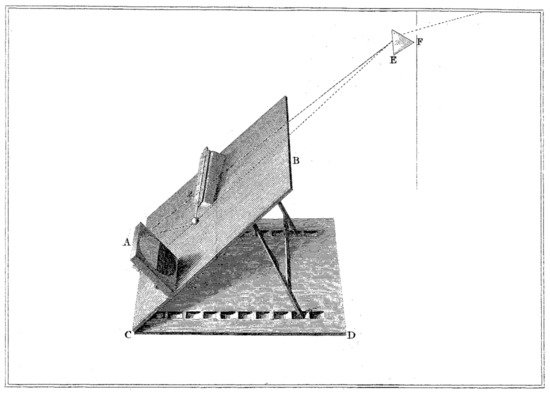

The measurement stand contains of an angle-adjustable stand, a small steel mirror positioned perpendicular to the incident sunlight split by a prism, half covered by cardboard limiting all visible sunlight feeding into it, and a thermometer, which was to receive the focused infrared rays reflected from the mirror. Lines perpendicular to the diameter were drawn on the cardboard covering the mirror, allowing the infrared rays to be accurately separated from the boundary-visible red rays of the split sunlight. After the thermometer reading had settled to the ambient temperature, Herschel exposed the half of the mirror used in the experiment to the scattered rays in such a way that the red rays were visible on the cardboard covering the other half of the mirror, 1/10 of an inch from its border.
By this experiment, Herschel confirmed the existence of invisible solar rays. He also proved the possibility of the reflection of these rays and, what was the subject of the experiment presented, their susceptibility to the phenomenon of focusing, which, in a short time, proportionately increases the heat energy created only by means of the invisible solar rays, i.e., infrared rays. In his experiment, he observed a temperature increase of 24° on the thermometer after two minutes of measurement.

